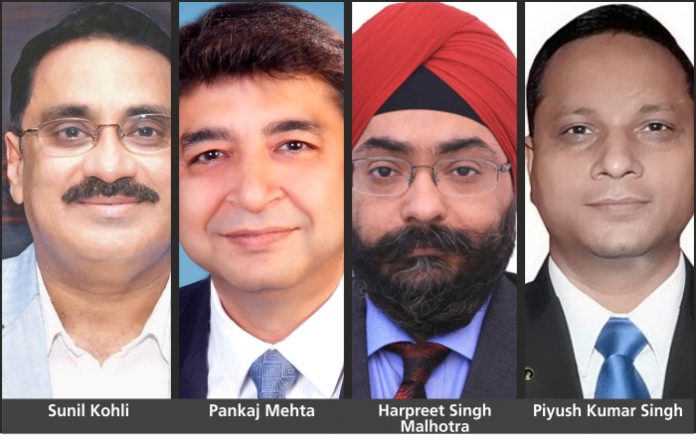The Centre has recently announced 1 lakh crore agriculture infrastructure fund at farm gate and aggregation point like primary cooperative societies and producers’ organisation. Industry experts talks about how this would help in managing the gaps in value chain which has happened due to lack of adequate cold chain and post-harvest management in the vicinity of farm gate.
Kalpana Lohumi
Sunil Kohli, Managing Director, Rahat Cargo
A proper harvest management has always been lacking for want of adequate availability of required infrastructure backed by vital logistics tools to yield a robust and encouraging outcome. Thus, the grant of funds by the government is likely to provide the fiscal assistance to the cooperative societies comprising the farmers and aggregators to strengthen their in-house facilities and fruitful deliverance. Further, the wastage and loss of products could be minimised with an efficiently operated cold chain which includes temperature-controlled storage space, transportation, and trained servicing personnel with state-of-the-art management procedures. The available fund would also help the stakeholders to manage temp-controlled storage space including the pack houses, ripening chambers to keep the perishables safe, delay degradation followed by improving their shelf-life. To have refrigerated transportation (reefer) at disposal is also a critical element of cold chain.
It is very unfortunate to have the outbreak of COVID-19 at a time when the crops are ready to be harvested. Furthermore, due to restriction on movement of vehicles, a shortage of farm workers has also emerged which has hampered the production. The local marketing of the products has suffered a setback because of the countrywide lockdown situation and curb on the movements. The export of perishables has also diminished due to non-operation of the scheduled flights from India whereas few available carriers have enhanced their freight rates to astronomical levels thereby desisting the shippers from exporting their products because of commercial constraints.
Due to the prevailing unfriendly situations having been caused by the natural calamity around the country, the stakeholders, farmers and farm labourers are at the receiving end and the products are getting lost due to several issues in the supply chain. Let us expect to have an improved and favourable scenario in the coming days which would again witness a surge in the cold chain supply activities.
Pankaj Mehta, Managing Director, Carrier Transicold – India & South Asia
The Indian cold chain landscape is witnessing a paradigm shift as the government has unveiled various measures to bridge the cold chain gap in the country. Indian agriculture is one of the main drivers of the country’s economic growth. It ranks high in production and is moving from a supply-driven to a market-driven segment. The announcements of Kisan Rail (or rail-based agriculture supply chain) in the budget for the seamless national movement of perishables, including refrigerated rail coaches and economic stimulus package announcement for agriculture will provide an impetus for the growth of sustainable cold chain in India.
Government support to create cold chain infrastructure at farms and marine and inland fisheries has focused on reducing food loss and achieving higher incomes for farmers. These measures are a testament to the growing and evolving cold chain ecosystem in India. An efficient post-harvest management and agri logistics system including aggregation, pre-conditioning, pre-cooling, and refrigerated transportation not only helps reduce food loss but also aids in expanding the reach to distant markets.
One of the most crucial links in the cold chain is refrigerated transport, as it maintains product integrity, translating to safe and nutritious food. The high waste produced from the absence of refrigerated transportation and lack of proper usage can lead to lower income for farmers since it is factored in the product cost. A well-established cold chain will play a pivotal role in establishing food security in India, thus opening a plethora of opportunities to farmers and various stakeholders in the agriculture value chain.
Harpreet Singh Malhotra, Chairman & Managing Director, Tiger Logistics India and India Cargo Awards winner 2019
As per previous estimates by the Associated Chambers of Commerce of India, India loses approximately 926 bn (US$ 14.33 bn) on account of PHL (Post-harvest food losses). Crop worth approximately US$ 19.4 mn is wasted on a daily basis only due to rejection at the farm gate and delays in the distribution process. A countrywide study measuring crop losses revealed that 3.9 – 6 per cent cereals, 4.3 – 6.1 per cent pulses, 2.8 – 10.1 per cent oilseeds, 5.8 – 18.1 per cent fruits, and 6.9 – 13 per cent vegetables were lost during harvesting, post-harvest activities, handling and storage. In a move to strengthen infrastructure in agriculture, financing facility of 1 lakh crore will be provided for funding agriculture infrastructure projects at farm gate and aggregation points.
Agriculturally-driven economic growth can have a strong impact on reducing poverty and hunger. Rapid productivity growth in rice and wheat and increasing market participation of smallholder farmers growing staple food crops have been driving the process of agricultural transformation in many places. Rising productivity of the agriculture sector also stimulated growth in non-agricultural sectors through forward and backward linkages. The sequence of steps and participants involved in the process from production to delivery of a product to market is called a value chain.
Post-harvest losses in India stem from a range of factors including lack of post-harvest infrastructure, limited technical know-how on good agricultural practices, imperfect market knowledge, and inadequate market access. Fragmentation of agricultural landholdings and a post-harvest value chain that is riddled with inefficiencies cause PHL to stack up progressively throughout the value chain. SHFs, comprising 80 per cent of India’s farming community, are affected by the challenges of fragmentation and value chain inefficiencies in the form of weak access to markets, low investment in agriculture, low productivity, and low income. The high volume of losses, if reduced, can generate significant value and address food insecurity.
Piyush Kumar Singh, Trade Consultant, Logistics & SCM
The COVID-19 outbreak has spread in India at a time when the crops are ready to be harvested. Due to restrictions on non-essential travel/movement, a shortage of farm workers has led to delay in the harvesting of crops which will hamper our food production. The farmers and farm labourers are at the receiving end of this undesirable situation and food is getting lost due to issues in the supply chain.
The wastage and loss of food could be minimised with a better prevalence of cold chain market and infrastructure in the country. A cold chain infrastructure includes temperature-controlled storage space, and transportation, trained operational, and servicing personnel with efficient management procedures.
The temperature-controlled storage spaces include pack-houses, ripening chambers, and bulk & hub cold storages which keep the perishables safe, delay degradation, and improve shelf-life. Refrigerated transportation (reefer) is a critical element of the cold chain as it ensures the safety and temperature of the products during their movement. The presence of well-trained O&M personnel, along with effective management procedures, accounts for smoother working of the cold chains. The cold chain infrastructure can also maintain the quality of vaccines and temperature-sensitive medicines from the time of their manufacturing to the point of administration and thus, adds to a robust healthcare system.
Figures
o As per second advance estimates for 2019-20 by the Ministry of Agriculture & Farmers Welfare, the food grains production for India is estimated to hit a record high of 291.95 million tonnes which is 2.36 per cent higher than the previous year.
o According to the Food and Agriculture Organization of the United Nations, one-third of food produced for human consumption is lost or wasted globally which amounts to about 1.3 billion tonnes per year.
o India is no different in this aspect where about 40 per cent of the food produced is lost or wasted.
o According to IBEF, India has the third-largest pharmaceuticals market in terms of volume and is the largest supplier of generic medicines globally.













